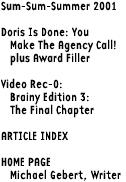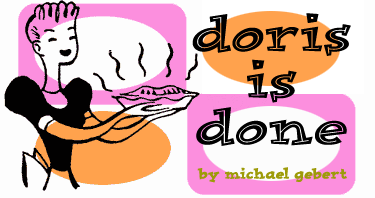


Mind you, I don’t blame all that on the New York guys’ creative. But the very fact that everyone involved is now dead gives us some freedom to take another look at what we did then—and ponder what we might have done differently. Everybody talks about thinking “out of the box” on projects—I can think of at least three occasions on Doris when we had the opportunity and a clearcut choice to do so. Could one of them have snatched victory from the jaws of bankruptcy? Let’s run the film again, and you make the call:
Focus Coups: The mainline agency’s print is flopping like Shamu the Whale in focus groups, while your supporting interactive work is scoring pretty well. What’s more, the client is starting to feel that the mainline agency is unable to deliver on the thing TV/print agencies lord over other shops—the supposedly unique ability to create a brand personality. The mainline agency’s focus on basic functionality rather than a grand vision (they even fight any attempt to call the product “she” instead of “it”) seems out of step with the great launch campaigns (Macintosh, VW, etc.), which were eager to make their products seem revolutionary—and human.
Do you: a) decide that this is the perfect moment for a coup, tell the client they need a new vision and you’ve got vision like Wal-Mart has plus-sized sweat pants, and try to steal the whole account away from the mainline guys; or b) stick to your supporting-media turf?
Demo Derby: Focus groups tell you people want to try the product before they’ll buy it online. You’ve created a Web demo, but you don’t want to wait for people to visit it. So you create a CD-ROM mailing that depicts the product as a trendy fashion accessory a la J. Crew (thus starting to give it some, ahem, brand personality). The client likes it, the focus groups love it. But... there’s no money in the budget for something like that. Maybe next year.
Do you: a) lean hard on the client to take dollars from the print and give them to you, as their one chance to build some awareness and make some sales right now; or b) wait for next year?
Leggo My Logo: For some reason the product doesn’t actually have its name on it anywhere. You think to yourself, what would Apple do in this situation? They’d make stickers so people could personalize the product in their own way, and thus make it—oops, her—that much more of a real person to them. In fact, Apple would do a hundred little guerrilla marketing things like that, because they’d understand that what you’re really creating here isn’t a brand, it’s a cult, and cults are created in the grass roots, not in mass media.
Do you: a) divert resources into exploring this uncharted area of guerrilla marketing strategies; or b) keep your focus on traditional marketing priorities like supporting the print?
Now, I have no proof that any of these out-of-the-box choice As would have helped at all. All I know is, in every case we took the safe and sensible choice B—and both product and agency were still dead within weeks.
It’s hard not to keep coming back to Apple as the standard by which to judge new branding efforts. Steve Jobs famously described Apple’s mission as being “insanely great”; we might have had a great product in Doris, but we weren’t willing to embrace the other side of the equation. We marketed her the conventional way in the usual media, and kept to our place beneath the mainline agency, and tried to start a revolution by coloring inside the lines. We were nothing if not sane—it says so right on our tombstone.
![]()
Now proudly shoved in a drawer: two Finalists, London International Advertising Awards, for Covalex print.
